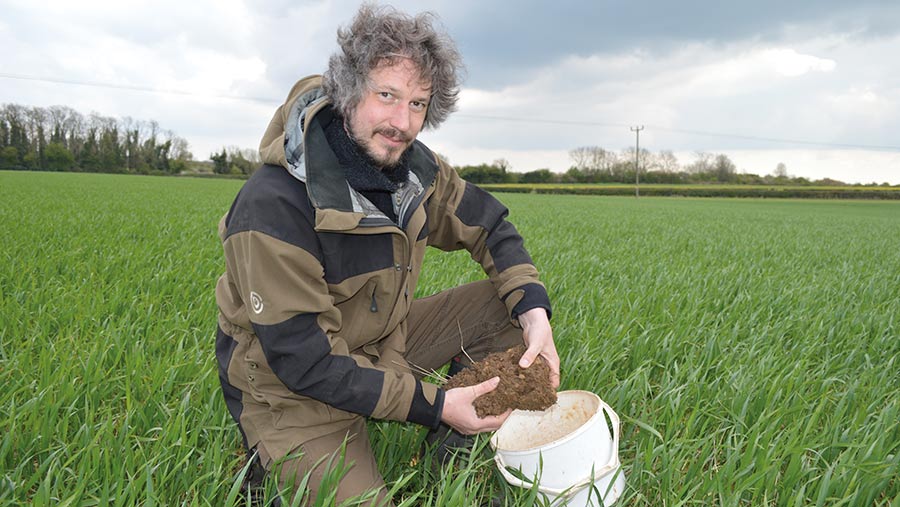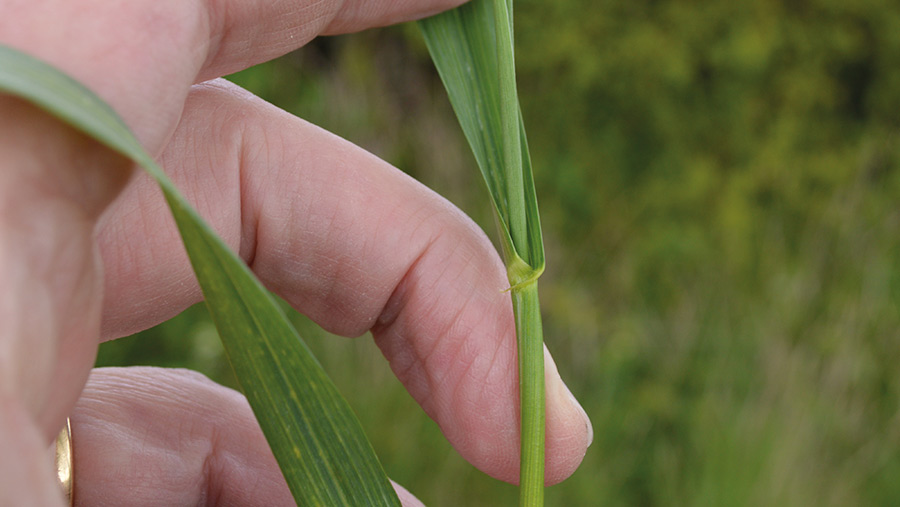A wheat grower’s 4 tests to get nitrogen application rates spot on
 George Renner © MAG/David Jones
George Renner © MAG/David Jones Rutland grower George Renner is testing the nutrition requirements of his winter wheat four times this season to get his nitrogen application rates spot on, which could lead him to either save money or increase his yields.
He plans to test the nitrogen content in his soils, the soil’s carbon content, tissue test his growing crop and then the harvested grain to ensure he is applying just the right amount to benefit his finances and the environment.
“We are looking to find the optimum rate of nitrogen, and so apply the right inputs to the growing crop just when it is needed,” he tells Farmers Weekly.
See also: Nitrogen and soil focus helps Norfolk grower win wheat prize
Fine-tuning
If he can fine-tune his nitrogen applications to the optimum rate, this could allow him to cut back on expensive fertilisers, or if the tests show he is short on nutrition then an increased rate could raise his yields.
These tests, especially the soil and carbon ones, are set to become more popular as growers take up the Sustainable Farming Incentive (SFI) under the Environmental Land Management (ELM) scheme, which pays growers for environmental benefits and replaces the old Basic Payment Scheme (BPS).
After testing his soils for soil nitrogen supply (SNS), he will also test for carbon content, tissue test just before the T1 fungicide stage and then test the harvested grain – so checking on the nutrition status of his wheat throughout the season.
Mr Renner has been conducting a number of tests on his soils over the past 10 years, but this is the first season he is trying the four-way approach to monitor levels throughout the season, using analytics company NRM for the tests.
His five-year average yield of winter wheat is 9.0-9.5t/ha, but in a good year it can be as high as 11t/ha.
In a poor one it can be as low as 6t/ha on his light soils where water is often the yield-limiting factor, and so he is keen to find out whether the benefits from testing will be worth the cost.
Good yields

Leaf three of a winter wheat plant emerging © MAG/David Jones
Mr Renner farms 310ha at Normanton Lodge, between Oakham and Stamford, with 122ha in winter wheat, largely seed crops, on light limestone brash soils with lots of stones, and is looking for ways of producing good yields without piling on the nitrogen.
He has been direct drilling for the past 23 years and returning all crop residues to the land for the past 30 years.
This keeps his costs low, helps with moisture retention and does a lot less harm to the soil than frequent ploughing.
His rotation includes a two-year break of a non-cereal crop between different wheat seed varieties, and this season he is growing varieties such as Skyfall and newer ones such as Grouse from RAGT and Bamford from Elsoms, both of which are not yet on the AHDB Recommended List.
He has been using liquid nitrogen over the past six to seven years in a three-way split, putting on 220kg/ha, but this season – for supply and price reasons – he has switched to solid urea at the same rate, applied in a two-way split
Break crop
The farm’s main break crop is 135ha of an AB15 two-year sown legume fallow under a mid-tier Countryside Stewardship scheme, while the rest of the farm area includes vining peas for seed and some grassland.
He has seen improvements in organic matter and soil structure with growing the two-year legume crop on his light soils, and it fits in well as a two-year break needed between different varieties for wheat seed production.
“We’ve seen real improvements in soil structure after the AB15, so we’re really keen to see what this is doing in terms of nutrients and carbon content,” he says.
Four tests

Allison Grundy © NRM
Allison Grundy, agronomy manager at NRM, says the four tests will give a good picture of how crop nutrients move in the soil and into plants.
“This will give us a better estimation of what is going on in the soil and the crop, and scope to save on nitrogen and other fertiliser inputs,” she says.
It is important to tailor nitrogen to the expected yield of the crop and if a grower over-estimates yield by 1t/ha when calculating nitrogen needs, the requirement could be as much as 25kg/ha of nitrogen more than is necessary.
“With nitrogen being so expensive, you really don’t want to be applying more than you need to. If we are to get fertiliser applications as low as feasible, all factors that can affect it have to be considered,” says Mrs Grundy.
The first SNS soil analysis is made up of three parts – what nitrogen is in the soil, what is in the crop and what nitrogen might be mineralised through the season.
The first is a physical soil test to determine soil mineral nitrogen (SMN).
The second is an assessment of the growing crop and Mrs Grundy says cereal crops sown in the autumn do not often take up much nitrogen by spring, and even the very forward ones may have only taken up 30-40kg/ha.
The third is gauged by the soil organic matter, as this will give an assessment of what nitrogen could become available.
As soils start to warm up in the spring, soil nitrogen mineralised from the pool of organic matter will start to rise.
Soil texture has a big influence on the rate of mineralisation.
Heavier soils take longer to warm up in the spring than light soils, but they have a bigger capacity to mineralise nitrogen as they warm up because they contain more clay and tend to have a higher soil organic matter content.
Summary of the four crop nutrition tests
1. Soil nutrient analysis
The SNS is made up for three elements.
First, a test for SMN, second, an estimate of nitrogen already in the crop, and third, what nitrogen will become available to the crop by nitrogen mineralised in the soil.
The first is a physical soil test usually conducted in February/March before crop growth starts, and the second is conducted by a tiller count – for every 500 tillers/sq m the crop is estimated to contain 15kg/ha of nitrogen.
The third is a soil organic analysis, which will give a value for what nitrogen might be mineralised as soils warm up. NRM offers a N-Check for SMN and N-Check Plus for SMN and soil organic analysis.
2. Soil carbon analysis
This can be conducted in the autumn or spring, and if the latter can be done at the same timing as the SMN test in February/March and looks to measure the total tonnes of carbon per hectare.
A carbon-nitrogen ratio can also be measured and 10-12 parts of carbon to one part of nitrogen is seen as the optimum range.
If there is a too high a carbon value this can block nitrogen release and if too low a carbon value the soil can start to run out of this element. The NRM test is called CarbonCheck.
3. Tissue test analysis
Samples of the growing wheat crop are taken in April at GS30/31 and tested for the major nutrients such as nitrogen, phosphate, potash and sulphur, and the minor ones such as boron, magnesium, zinc etc.
This is a useful tool to head off any potential deficiencies before they become an issue. If nutrition problems do occur in the crop a later test at GS32-37 can be conducted. The NRM test is called CropCheck.
4. Harvest grain analysis
This final test on the grain can determine if the crop was short or had too much nitrogen with feed wheat grain typically 1.9% nitrogen. The NRM test is called GrainCheck.

